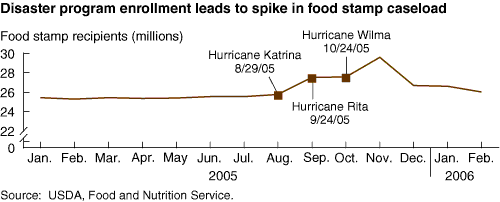Emergency Food Assistance Reaches Hurricane Victims
- by Kenneth Hanson
- 9/1/2006
Food Stamp Program participation spiked in November 2005 at 29.6 million people, up from 25.8 million 3 months earlier. By January 2006, the number of Americans receiving food stamps had dropped to 26.6 million. The sudden jump in caseloads reflects USDA’s efforts in getting food stamps to people in need in the wake of the destruction wrought by Hurricanes Katrina, Rita, and Wilma last fall. This additional food stamp spending also represents an injection of funds into businesses rebuilding after the storms.
When a disaster strikes, people may need emergency food assistance. USDA’s Food and Nutrition Service (FNS) delivers this assistance in two ways. Initially, emergency food is provided to shelters, other mass feeding sites, and directly to households. In the weeks following Hurricane Katrina, 20 million pounds of FNS-funded food was delivered to Louisiana, Texas, Alabama, and Mississippi. State food stamp agencies implemented their disaster plans and distributed their warehoused food supplies.
Once grocery stores and other retailers in the affected areas are operating again, FNS issues emergency food stamps through the Disaster Food Stamp Program, a program funded by the Federal Government but administered by the States. Under the program, the Secretary of Agriculture establishes temporary eligibility standards for households who are victims of the disaster. Benefits are provided to households who suddenly need food assistance because of disaster damage to their homes, expenses related to protecting their homes, lost income, or lack of access to bank accounts or other resources. Eligibility verification and reporting requirements are temporarily relaxed. The Secretary can also provide emergency food stamps to existing food stamp households whose food was destroyed in a disaster. Flexibility in program regulations allows States to adjust to the needs of the circumstance. Between September and December 2005, 1.6 million new households received food stamp benefits through the Disaster Food Stamp Program. An additional 676,000 households had benefits replaced due to destroyed food. Benefits issued amounted to $900 million.
As recipients use the food stamps to purchase food from local retailers, the benefits become revenues for retailers, contributing to the economic recovery of the community. The food spending brings people back to work in both the stores and the local businesses that support the stores, such as wholesalers and delivery companies. This flow of resources helps rebuild businesses and communities.
This article is drawn from:
- Oliveira, V. (2006). Food Assistance Landscape, March 2006. U.S. Department of Agriculture, Economic Research Service. EIB-6-2.


